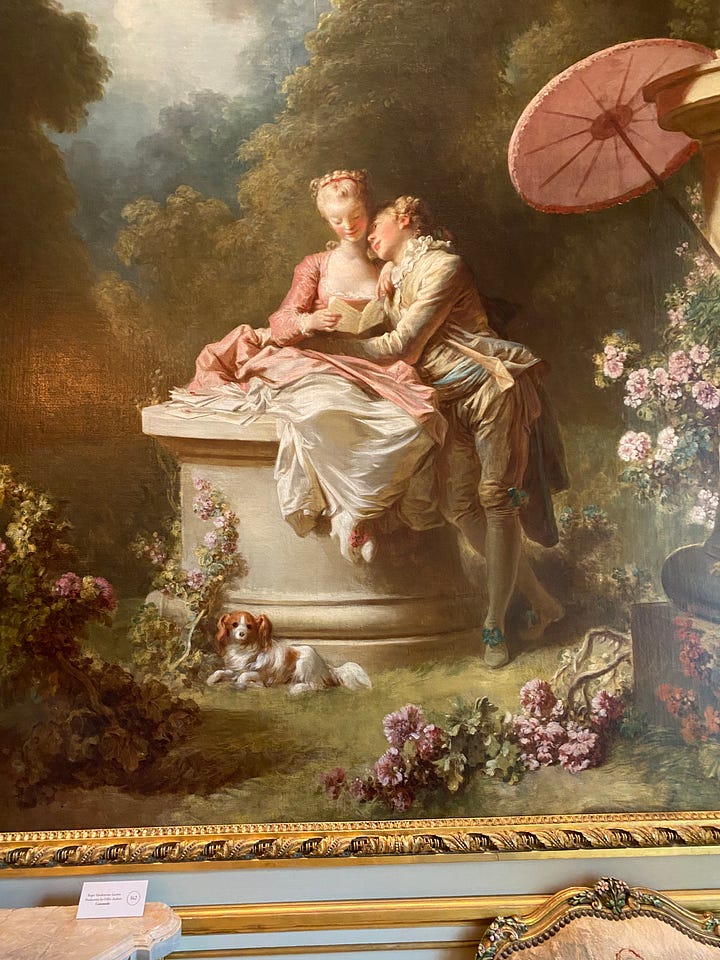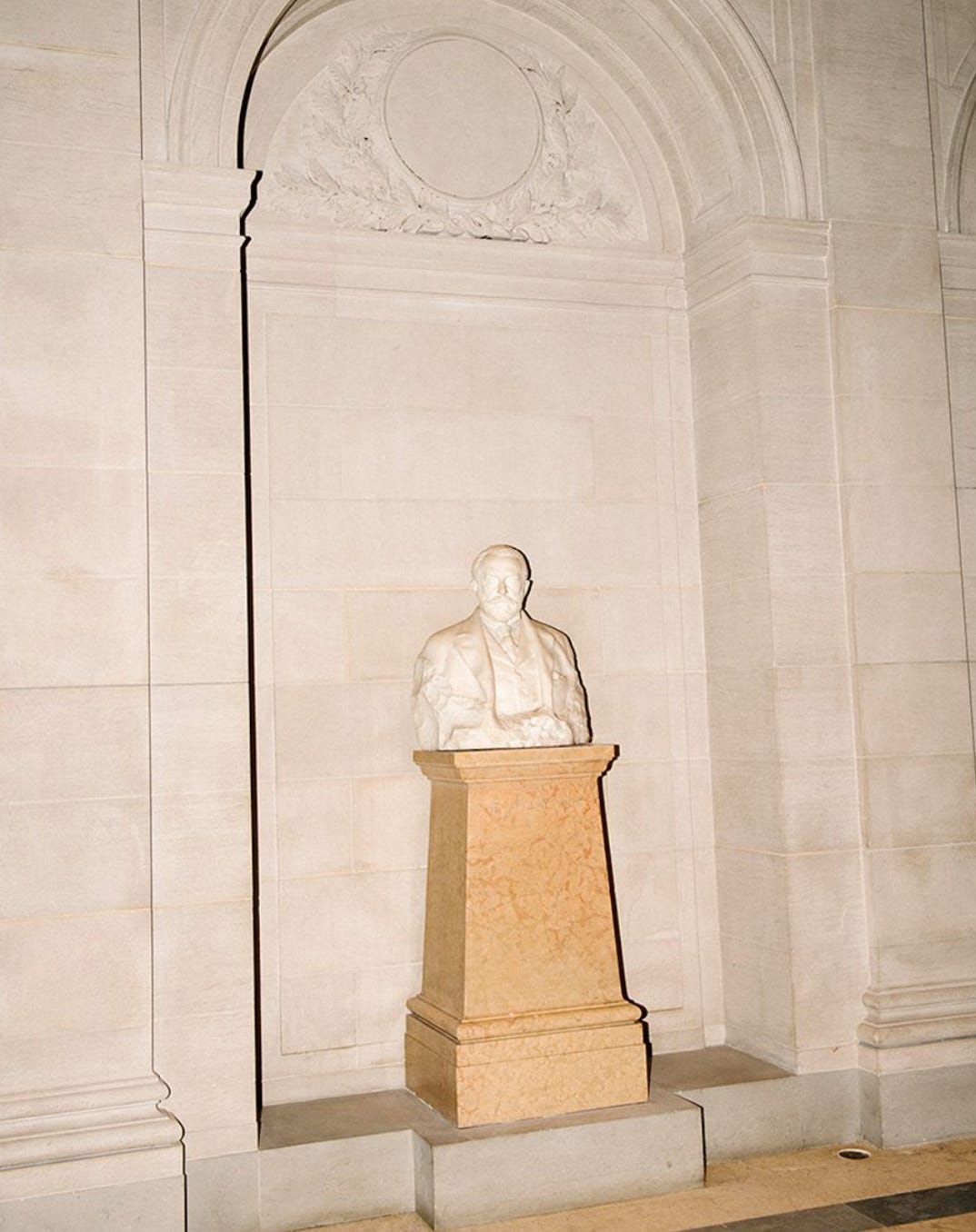I said I wasn’t going to do it beyond the confines of my Instagram, but I just can’t help it.
Here are some thoughts about the Frick. First, the bad (my grudges).
As a child, and a particularly inquisitive child who lived a mere four blocks or so away from the Met, going to museums was not only what we’d do on rainy days, but one of my most favorite and cherished activities. What a total stroke of luck and privilege to shimmy into a tutu and pose next to Degas’ Little Dancer, or pretend to be chased by elephants in the Hall of African Animals at the Museum of Natural History. Never jaded, always excited, I remember getting dizzy going down Frank Lloyd Wright’s immense spiral at the Guggenheim, wanting to dunk my finger into the dollop of whipped cream on a Wayne Thiebauld pie at the Whitney. These experiences became the cornerstone of my love of art, and even if I hadn’t gone on to work in the industry, opened my mind to ways of seeing, cultures different than my own, and a deep appreciation of the long arc of history and my place in the world.
But you know how it is when you tell a child (or any person, really) they can’t do something? It only makes them want to do it more. I had every door open to me as a kid in New York but one (total privilege because not only are my parents the type of people who made bringing their children into museums a part of how they wanted to raise us, but could afford to do so; the ticket prices for many of the aforementioned museums are prohibitive, but that’s another rant I’m happy to go on another day). A beautiful late 19th c. gilded-era mansion kissing the park a mere 10 blocks or so away from my prized Met, the Frick was unequivocally off-limits to children under ten. Even at seven or eight I had the self-awareness to be offended by this restriction; “you’re telling me I can go into every other museum filled to the brim with priceless works of art and be trusted to not run around like I was the circus, but this one museum?” I had been taught to look politely, god damnit! Even then, just the mere insinuation that children could not be trusted set off a reaction so deep that when I became of age to enter the museum, I stubbornly put it off. If they didn’t want me at my cutest, why should they get me at my arguably most miserable? The sour taste left in my mouth from my childhood of the Frick’s stringent anti-children rules has lasted well into my adulthood; as a person who thinks children should be exposed to the arts, I can’t ignore the bullheadedness of the Frick’s decision to keep this policy in place, especially after the renovation.
I also take issue with the Frick’s stubbornly behind the times anti-photo rule. In the days and weeks preceding its opening to the public, The Frick invited influencers and art professionals with high followings and professional standings to explore the space and take photos of it. My Instagram was flooded with such images - to be clear, I don’t begrudge any of these professionals and those who were invited to the “Frick Community Day” for taking and posting these photos, they were doing what everyone should have the ability to do. However, if we only let some people take photos (yes, even if they are for publicity), what are we saying about who can interact with art and in what way? Professionals cannot and should not be the only people allowed to take photos at the Frick, especially in our increasingly digital world; you never know who will be inspired by a work or the beautiful museum, and want to snap a photo. Whether or not photography at museums has soured part of the viewing experience is up for a very long debate, however, it’s ridiculous to ignore the fact that many interact with art now through their phones and social media. If the building can get with the times, why not this policy?
Now, for the good stuff:
When the Frick announced its renovation, coinciding with the Whitney’s tremendous move downtown, (which I still have mixed feelings about, although less regarding the meatpacking museum itself and more about the Spirt-Halloween-ification of The Breuer) I was curious about how these masterpieces of the European canon would fare in The Breuer space that I would (generously) describe as best being suited to modern and contemporary art. I won’t bore you with a complete revisiting of this time; suffice it to say, I am glad (thrilled, really), that the pieces are back in their rightful home.
Earlier this week, I had the honor to attend the “Frick Community Day” opening simply because I have good friends who text me on a whim (thanks, Phoebe!). The building and renovation are tremendous. Absence does make the heart grow fonder; the last time I had walked through the building was about ten years ago, and it didn’t sparkle with the fresh sheen of glamour with which it does now. The more orderly sister to its freewheeling and fun-loving similar late 19th c mansion come-museum - the Isabella Stewart Gardner, the Frick is sumptuous without ostentation, she’s a confident girl about to apply to Harvard or Princeton ED. The Frick is polished and poised.
Wowed by the exquisite and fragrant florals strewn throughout the lobby, you are ushered to the clear threshold of the old mansion. Phoebe and I started off in the dining room, punctuated with several large Gainsborough portraits and pale greens and golds. From there we crossed a small hallway, where four Boucher paintings were hung. These were a bit too saccharine and Hallmark-card-
like for my taste, however, they were a great primer for the breathtaking Fragonard Room. The Fragonard panels are embedded into the walls of this room, drawing the viewer in – the original “immersive” experience. You can really imagine the cupids zipping around the gold-rimmed walls, chubby, jubilant, delightful. Fragonard’s “The Progress of Love” is lush, and hums with the sweet frivolity of the Rococo movement, transporting us not to late 19th century America, but right to the precipice of the French Revolution.


If The Fragonard room is soft and feminine, then make no mistake, The Living Hall is the macho man; if it had been built by a man of lesser taste, it would have certainly been a billiard room. Don’t tell the guys at Barstool Sports. The room’s lacquered tables, dark red oriental rug, and deep mahogany wood walls alongside a plethora of velvets, create a complete 180 vibe shift from the airiness and light of the previous rooms. This is where the bros hang out, from El Greco’s “Saint Jerome”, to Hans Holbein the Younger’s portraits of Sir Thomas More and Thomas Cromwell doomed for eternity to continue their theological spat facing off in this room. Finally, The Frick’s beloved Giovanni Bellini, “Saint Francis In The Desert “ hangs here, released from the penitence of the first floor of the Breuer. At the Breuer, this painting, though still positioned close to the light, appeared dour; in its rightful home it shines. Moving on.
Verdant and spectacular, The West Gallery holds true gems of the collection. I was particularly enamored of the Dutch portraiture here, which shines against the forest greens of the floor and walls, and the perfect creamy skylight. Van Dyck’s portrait of Margareta de Vos, a woman who perhaps did not care for having her portrait painted -as suggested by her unsure expression, was a highlight for me, as was Vermeer’s “Mistress and Maid” where the light is just so perfect brushing through the mistress’ canary yellow coat.
I couldn’t quite figure out what bound together the works in the West or the East Gallery, where the walls are a muted crimson against set against beautifully interwoven wood paneled floors. The Met’s European Hall rehang this is not, the works are neither from the same period nor place, here they are bound together perhaps based on color and vibe. In this gallery, as well as the rooms upstairs, Vladimir Kavensky’s porcelain flowers, which are meant to evoke the museum’s live bouquets when it first opened to the public in 1935, are whimsically placed. The porcelain flowers pop up throughout the building, some in a kind of “Where’s Waldo” fashion. Some feel organically placed, like the lilacs in the Dining Room which I wish came with a smell function. In the East Gallery, the burgundy and white hollyhocks sprout up from their pots and seem to view the work alongside visitors. Upstairs, they reside in fireplaces long shut. Going to write that tip down in my “interior design ideas” note on my phone.
Ascending the grand staircase, made of a deep caramel marble, to the second floor is a must- as is descending the sleek Sellendorf stair on your way out - like stepping in and out of a time machine. Upstairs is quieter than down, a place for contemplation. I was greeted by a beautifully painted ceiling in a hallway, reminiscent of Italian Renaissance buildings; it’s fitting then that the bulk of Helen Clay Frick’s Renaissance collection resides here. I’m a Lippi girl so gold stars went to Lippi’s Annunciation my favorite here.

If this makes you all want to lie down, I suggest you go ahead and do so in Frick’s bedroom. The man clearly never met a wood-paneled room he didn’t like, but I, on the other hand, like the curatorial team’s choices here. Namely, choosing works that soften the harshness of the wood, resulting in a harmony of art and space. Two of my favorite works in the museum are hung across from each other here- “Louise, Princesse de Broglie, later the d'Haussonville” by Ingres, and “Emma Hart, later Lady Hamilton as ‘Nature’” by George Romney. No other room perhaps better tries to reconcile the gender politics of the Frick, which oscillate between the masculine and feminine. In Frick’s bedroom, the portraits of the two women feel like it is they, not Frick, who have ownership of the space (is this a bit like you wearing the clothes vs the clothes wearing you? Maybe). Frick, interestingly enough, chose to place Emma in this room, and clearly loved this painting (so he and I agree), and there’s something so incredibly tender about this placement as it would be the first thing he’d see in the morning and last at night.
Ronald Lauder’s building, along with Annabelle Sellendorf’s new additions, glows at every turn. Soft sunlight dapples the windows and skylights, porcelains shimmer, and each fixture fuses grandeur and coolness. This is punctuated by Sellendorf’s designs, which consistently meet the moment wherever they’re applied. Half of Sellendorf’s fixes were not open to us. The café, for example, already looks like the perfect place for tea; Phoebe and I snuck peeks of it behind a screen, proving that while children are not allowed in the space, child-like behavior from 30-year olds remains somehow welcome. Despite the ban, which I will forever maintain is a terrible idea, my visit to the Frick unlocked a childlike wonder in me; I just wish little ones could feel it, too.









Loved this piece! I didn't know The Frick STILL doesn't allow children, and I hate that. Art shouldn’t happen in a vacuum. It’s too precious a resource not to be accessible to all!